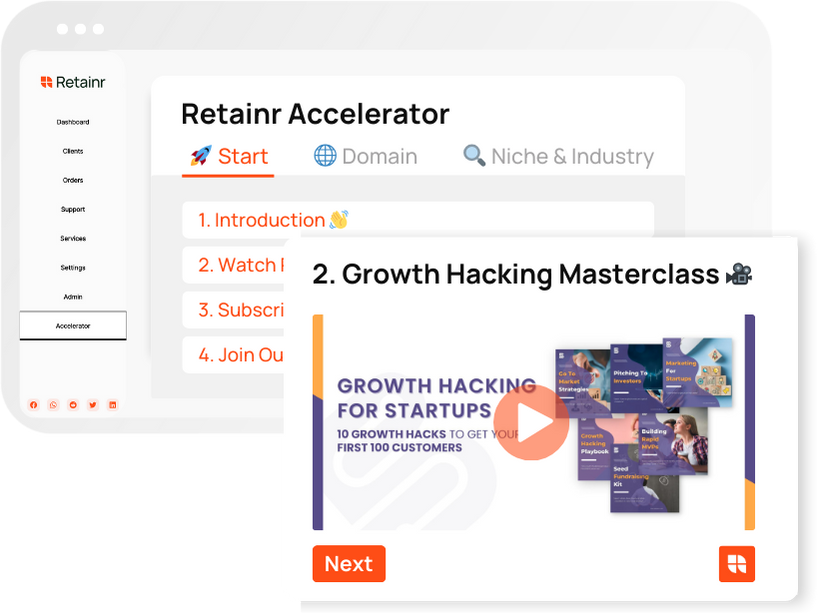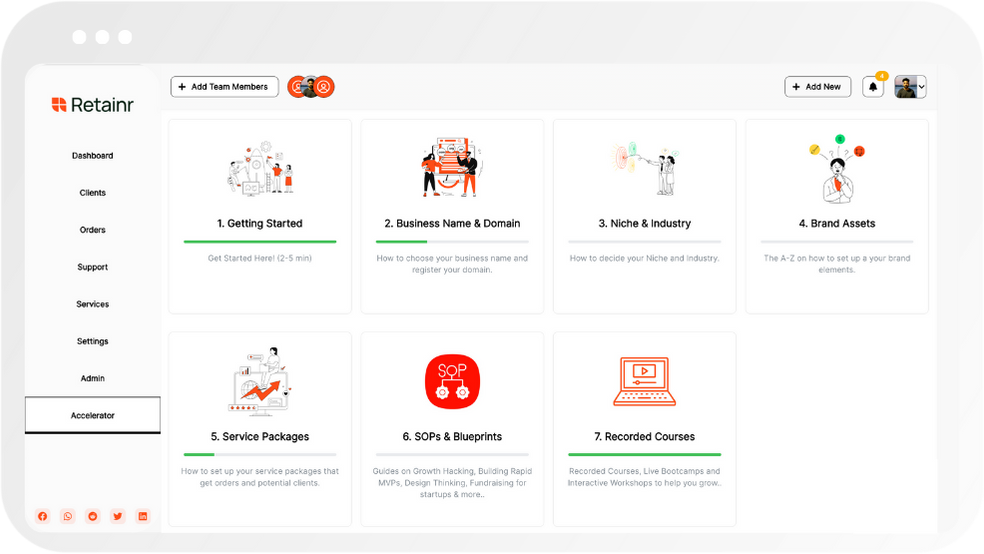
How to Develop an Effective Marketing Strategy: 8 Key Steps
Build with Retainr
Sell your products and services, manage clients, orders, payments, automate your client onboarding and management with your own branded web application.
Get Started1. What are the eight key steps to develop an effective marketing strategy?
Understand Your Audience
To develop an effective marketing strategy, the first step is understanding your audience. This can be accomplished through various means such as surveys, interviews, and market research. By understanding who your audience is, you can create a marketing strategy that targets their needs and wants.
- 1. Market Research: This involves collecting and analysing information about your target market. This can include demographic data, purchasing habits, and consumer preferences.
- 2. Create Buyer Personas: Based on your market research, create personas that represent your ideal customers. This will help you understand their needs, interests, and challenges.
- 3. Identify Key Customer Segments: Group your customers into segments based on their needs and behavior. This will allow you to target your marketing efforts more effectively.
Define Your Goals and Objectives
Once you understand your audience, the next step is to define your marketing goals and objectives. These should align with your overall business goals and be specific, measurable, achievable, relevant, and time-bound.
| Marketing Goals | Marketing Objectives |
|---|---|
| Increasing brand awareness | Reach 1,000 new potential customers per month |
| Boosting product sales | Sell 50% more products within the next quarter |
| Improving customer retention | Reduce customer churn rate by 10% by the end of the fiscal year |
Develop Your Marketing Mix
The final step is to develop your marketing mix, also known as the four Ps of marketing: Product, Price, Place, and Promotion. These are all elements that need to be adjusted to ensure your product or service meets the needs of your target audience and generates maximum profits.
- 4. Product: Define what your product is, what it does, and why it's unique.
- 5. Price: Determine how much customers are willing to pay for your product.
- 6. Place: Identify where your product will be sold, whether it's online, in physical stores, or both.
- 7. Promotion: Decide on which promotional methods you'll use to raise awareness and generate interest in your product.
- 8. Performance Evaluation: Regularly measure and analyze the performance of your marketing initiatives to ensure they're delivering the desired results.
2. How do you define your marketing goals effectively?
Defining Your Marketing Goals
Setting clear and achievable marketing goals is a crucial aspect of any effective marketing strategy. These goals serve as a roadmap, guiding your marketing efforts and helping you to measure your progress. When setting your marketing goals, there are several key steps to consider:
- Align with Business Objectives: Ensure your marketing goals are directly aligned with your overall business objectives. This could range from increasing product sales, entering new markets, improving customer satisfaction, or building brand awareness.
- SMART Goals: The goals should be Specific, Measurable, Achievable, Relevant, and Time-bound. Specific targets make it easier to develop focused strategies, measurable goals allow for performance tracking, achievable and relevant goals ensure they are realistic, and time-bound goals provide a clear timeframe for achieving these objectives.
- Target Audience: Understand who your target audience is. This knowledge helps to frame your marketing goals around the needs and desires of your potential customers and increases the likelihood of achieving your goals.
Types of Marketing Goals
There are several types of marketing goals that businesses may aim to achieve depending on their specific needs and circumstances. Below is a table highlighting a few types of marketing goals:
| Type of Goal | Description |
|---|---|
| Brand Awareness | This refers to increasing the familiarity of potential customers with your products or services. It involves measures like increasing social media engagement, website traffic, or participation in events and trade shows. |
| Customer Acquisition | This involves gaining new customers for your products or services. Strategies may include targeted advertising, referral programs, or offering promotional incentives. |
| Customer Retention | This refers to the ability to retain customers over a period of time, encouraging repeat purchases. This could be achieved through measures like customer loyalty programs, excellent customer service, or regular communication. |
In conclusion, understanding how to effectively define your marketing goals is indispensable to the success of your marketing strategy. Having clear, relevant and measurable goals provides focus for your marketing efforts, and makes it easier to gauge your progress and adjust as necessary.
3. What impact does identifying the target audience have on a marketing strategy?
Identifying Your Target Audience
Identifying your target audience is one of the most critical steps in developing an effective marketing strategy. It influences every other element of your plan, including the platforms you choose, the messages you craft, and the products or services you promote.
Influence on Marketing Platforms and Channels
Identifying your target audience can significantly impact the marketing platforms and channels you utilize. For example, if your target audience is teenagers, focusing on platforms popular with this demographic like Instagram or TikTok might yield high returns.
- Demographic: This includes age, gender, location, employment status, income level, and education level. Knowing these can help you select the right platforms to reach your audience effectively.
- Psychographic: Interests, lifestyle, values, behaviours, and attitudes also play an essential role in determining the platforms where your audience spends most of their time online.
The Impact on Message Crafting
In addition to the selection of marketing platforms, understanding your target audience can tremendously influence the message you are delivering.
| Target Audience | Branding Example |
|---|---|
| Parents | Messages might focus on safety, value for money, and convenience. |
| Young Adults | Conversely, if the audience is younger, the branding could be more fun, cool, and trend-driven. |
| Professionals | If the audience is professionals, the focus could be more on quality, performance, and status. |
To conclude, identifying your target audience has a profound impact on marketing strategy. It helps streamline your marketing efforts, optimize resource allocation, create relatable content and eventually, drive more conversions and increases overall business profitability.
4. How do you conduct a market analysis for an effective marketing strategy?
Understanding Your Market
The first essential step in marketing analysis involves getting an in-depth understanding of your market. This part of the analysis lets you grasp who your customers are, what they require, and how you can reach them. It involves three key steps:
- Identifying your customers: describes the demographic, geographic, and psychographic characteristics of your preferred audience.
- Understanding customer needs: provides the reasons customers may desire your products or services.
- Determining how to reach your customers: includes selecting the best marketing channels to reach your target market, such as email, social media, SEO, or traditional advertising.
Competitive Analysis
The second step in market analysis involves a comprehensive competitive analysis. Understanding what your competitors are doing, their strengths and weaknesses, provides you with critical insight on how to differentiate your own products or services. Below are the steps in conducting a competitive analysis:
- Identify major competitors: Documenting who your present competitors are.
- Analyse competitor products and services: Understanding what your competitors offer in-depth.
- Analyze their marketing strategy: Identify the marketing channels your competitors use, along with their strategic focus.
- Understand their pricing structure: This can offer insights into their cost structure and value proposition.
Defining Market Trends
The third step involves defining market trends. This is crucial in understanding the direction your market is moving, helping you to position yourself effectively for future growth. You can summarise market trends in the following table:
| Trend | Implication | Action |
|---|---|---|
| Trend 1 | Describe how this trend affects your market and business | Outline strategic actions that your company can take to exploit or mitigate this trend |
| Trend 2 | Again, describe its impact | Outline more strategic actions |
By following this step-by-step approach to conducting a market analysis, you can better understand your customers, your competitors, and your market. This knowledge will then form the basis of an effective marketing strategy.
5. What are the considerations when setting up a budget for a marketing strategy?
Considerations for Setting a Marketing Budget
Setting up a budget for a marketing strategy is key to reach success. It requires careful considerations in order to ensure effective use of business resources. Some of the factors that have to be taken into account include:
- Identity of Target Market: Understanding your target market is vital in creating a budget. Determining the sectors you are targeting helps in allocating money towards the resources that will best reach your clients.
- Marketing Channels: Different marketing channels may require different funding. If social media is your primary channel, the amount required might be less compared to print media or television advertisements.
- Overall Business Goals: The marketing budget should align with the overall goals of your business. If becoming a market leader is your goal, a larger budget might be required to support aggressive marketing strategies.
Understanding Costs
Additionally, understanding the cost structure of your marketing initiatives is another pivotal consideration. It's important to identify the potential costs that could arise during the execution of your marketing strategy. These could include:
| Type of Cost | Example |
|---|---|
| Fixed Costs | Costs that stay constant regardless of how many goods or services are sold, such as rent or salaries. |
| Variable Costs | These costs vary with the number of goods or services that your company produces, for example, production and distribution costs. |
Overhead Costs
Lastly, it's crucial to not forget the effect of overhead costs on your marketing budget. These are the costs not directly tied to a specific business activity but are necessary for the overall functioning of the company. Examples of overhead costs that could influence your marketing budget include:
- Administrative expenses: These costs are associated with the administration of the business as a whole. This can include salaries of non-production employees, rent, utilities and office supplies.
- Selling and marketing costs: These are the costs of promoting and selling your products or services. They can include expenses associated with advertisements, sales commissions, and direct mail campaigns.
6. How do you define the unique selling proposition in the marketing strategy?
Understanding the Unique Selling Proposition
The Unique Selling Proposition (USP) is the factor or consideration presented by a seller as the reason that a product or service is different from and superior to that of the competition. This is what sets your product or brand apart from others. Here's how you can define the USP in your marketing strategy:
- Identifying what makes your product unique: This can be done through examining the features, advantages, and benefits of your product or service. Should you find that they are the same as those offered by your competitors, then you will need to create a new aspect that would differentiate your product or service.
- Understanding your target audience: Knowing who your main customers are can help you tailor your USP to meet their needs. This may involve conducting market research to find out more about your customers' preferences, habits, and demographics.
- Communicating your USP: Once you have identified your USP, you need to communicate it to your audience. This can be achieved through advertising, public relations, and social media marketing.
Key Considerations in Defining USP
The following table highlights some key considerations when defining your unique selling proposition:
| Consideration | Description |
|---|---|
| Product Functionality | How does your product or service work and in what ways is it better than those offered by your competitors? |
| Price | Is your product priced more competitively than those offered by your competitors? Does it offer better value? |
| Quality | Is the quality of your product or service better than those offered by your competitors? |
| Brand Image | Does your product or service have a strong brand image that resonates with your target audience? |
Integrating the USP into the Marketing Strategy
Once you have defined your USP, it is essential to integrate it into your overall marketing strategy. This means including it in all marketing communications, from your website and social media profiles to billboards, print ads, and TV commercials. Remember, a USP is not just a slogan or a catchphrase. It should be the core message that runs through all your marketing activities and resonates with your target audience, making your brand stand out from the competition.
7. How is a content strategy created and integrated into the overall marketing strategy?
Creating a Content Strategy
Creating a compelling content strategy is key to effective marketing. Firstly, you need to define your goal and understand your audience. The goal may be to increase brand awareness, drive more traffic, generate leads, or convert more sales. Next, your audience's preferences, behaviors, and pain points should be thoroughly researched. Once the goal and audience are clear, you can start brainstorming content ideas that will achieve your goal and appeal to your audience.
The content may be in various formats such as:
- Blog posts
- Infographics
- Videos
- Podcasts
- Social media posts
Integrating Content Strategy into the Overall Marketing Strategy
Once you have outlined your content strategy, integrating it into your overall marketing strategy is the next important step. This can be achieved using various approaches:
- Consistency: Ensure all content aligns with your brand message and overall marketing goals.
- SEO: Make sure your content is search engine optimized to boost visibility and attract organic traffic.
- Promotion: Leverage all marketing channels to promote your content, from social media to email newsletters.
Overview of the Content Strategy Creation and Integration
| Steps | Actions |
|---|---|
| Define Your Goal | Identify what you want to accomplish with your content. |
| Understand Your Audience | Research your audience's preferences, behaviors, and pain points. |
| Brainstorm Content Ideas | Create content that aligns with your goal and appeals to your audience. |
| Create the Content | Produce the content in different formats that suit your audience best. |
| Integrate into Marketing Strategy | Ensure consistency, use SEO, and promote the content on all marketing channels. |
8. What are the techniques to develop an effective promotional strategy?
Identifying Target Audience
The first step in developing an effective promotional strategy is identifying your target audience. This involves understanding who your customers are, their wants, needs, and preferences. This can be achieved through market research and analysis of customer data. The information gathered can help in designing promotional messages that resonate with them and increase their chances of engagement.
- Demographic Information: Age, gender, occupation, income level, etc.
- Geographic Information: Location, urban/rural, etc.
- Psychographic Information: Lifestyles, behavior, interests, etc.
Choosing the Right Promotional Mix
The next step is to decide on the promotional mix. This involves selecting the most suitable promotional tools to use based on your target audience, the product or service being marketed, and the business’s goals and budget.
| Promotional Tool | Advantages |
|---|---|
| Advertising | Reaches a large audience, multiple media options |
| Public Relations | Builds credibility, can manage public image |
| Direct Marketing | Personal, high audience targeting |
| Sales Promotion | Immediate impact on sales, attracts price-sensitive customers |
| Personal Selling | Flexible, high persuasive potential |
Creating a Unique Selling Proposition (USP)
The final step is creating a Unique Selling Proposition (USP). Your USP is what distinguishes your product or service from your competitors. It is the unique benefit or advantage that makes your offering stand out in the crowded marketplace. This should be clearly communicated in your promotional messages.
- What makes your product/service unique?
- What exclusive benefits or features does it offer?
- How can it solve customer’s problems or meet their needs better than the competition?
9. How do you monitor and adapt the marketing strategy?
Monitoring The Marketing Strategy
Monitoring a marketing strategy is a continuous process that helps to understand the efficiency of the strategy in achieving targeted goals. Key elements for effective monitoring include:
- Establish success parameters: Before initiating a marketing strategy, it's important to set measurable targets.
- Review progress: Regularly check the progress on set parameters to understand how your strategy is working.
- Digital Analytics: Use tools like Google Analytics to measure web traffic and visitor's behavior.
- Social Media Analytics: Analyze likes, shares, comments, follower growth, and engagement on your social media pages.
- Sales Reports: It's important to monitor sales before, during, and after campaigns.
Adapting The Marketing Strategy
Adapting a marketing strategy according to dynamic market situations is crucial to maintain relevancy. Simple steps to adapt your strategy include:
- Analyze trends: Keep up with market trends and integrate them into your marketing strategy.
- Customer Feedback: Use feedback from customers to make improvements.
- Keep an Eye on Competition: Track your competitors' activities and make necessary adjustments to keep up.
- Experiment: Try out new strategies and ideas on a small scale before fully implementing them.
Monitoring and Adapting Strategy in a Table
| Parameters | Monitoring | Adapting |
|---|---|---|
| Success Parameters | Set measurable targets | Align with market trends |
| Progress Review | Regularly check progress | Integrate customer feedback |
| Digital Analytics | Measure web traffic, visitor's behavior | Adapt according to competitor's activities |
| Sales Report | Monitor sales before, during, after campaigns | Experiment new ideas |
10. Can you provide examples of companies that used these 8 steps to develop successful marketing strategies?
Coca-Cola’s Share a Coke Campaign
The iconic beverage company is known for its remarkable marketing strategies. One perfect illustration of their effective marketing strategy would be their 'Share a Coke' campaign. Sticking with the 8-step marketing strategy process:
- Identifying the Target Market: They targeted millennials who shared a lot on social media.
- Understanding the Market Needs: Coca-Cola identified the general desire for personalized products.
- Defining Marketing Objectives: Increase brand awareness and sales during summer.
- Defining Positioning Strategy: Create a personalized brand experience.
- Defining Marketing Mix: They involved every marketing channel including print, digital, outdoor and TV.
- Formulating Budget: The campaign involved substantial budget due to its global scale.
- Implementation: The campaign rolled out in 80 markets.
- Evaluation & Control: The company reported increased sales volume for the first time in a decade.
Nike’s Colin Kaepernick Campaign
Nike's "Dream Crazy" advertising campaign featuring Colin Kaepernick is another prime example of successful implementation of the 8-step marketing strategy:
| Steps | Nike’s Colin Kaepernick |
|---|---|
| Identifying the Target Market | Young, diverse urbanites |
| Understanding the Market Needs | Acknowledgement of social justice issues |
| Defining Marketing Objectives | Strengthen commitment to social issues and athletes |
| Defining Positioning Strategy | Empowerment and taking a stand for beliefs |
| Defining Marketing Mix | Digital media, poster advertisements, and TV |
| Formulating Budget | Budget allocation towards producing high-quality video and web content, outdoor and TV marketing |
| Implementation | Launched before an NFL season |
| Evaluation & Control | Increased sales and earned media coverage |
Conclusion
1. Understanding your customer
The first step in developing an effective marketing strategy is understanding your customer. Knowing who your ideal customer is, what they need, and how they make decisions is critical. Use Retainr.io to manage your customers effectively in a unified platform and respond efficiently to their feedback.
2. Identify your business goals
Having clear business goals is paramount to defining your marketing strategy. Your marketing goals should align with your business objectives. With Retainr.io, set actionable targets and monitor their progress.
3. Market research
Conduct thorough market research to understand your position in the market. This includes identifying your competitors, understanding their strategies, and finding gaps that you can leverage. Use Retainr.io, our whitelabel software, to keep track of customer insights, behaviours, and trends to stay ahead of your competition.
4. SWOT Analysis
Perform a SWOT analysis to identify your Strengths, Weaknesses, Opportunities, and Threats. Retainr.io's comprehensive dashboard provides you with an overview of your performance at any given time to inform your decision making process.
5. Develop your marketing tactics
From social media promotion to SEO to email marketing, choose your marketing tactics wisely. Retainr.io can help manage all your marketing activities with its all-in-one platform.
6. Budget planning
Planning your budget effectively resources is critical to execute your marketing strategies. Use Retainr.io to manage your resources and budgets, helping you measure the ROI of your investment.
7. Implementation
Having planned your marketing strategy, the next step is to implement it. Utilize Retainr.io to manage client orders and payments, making the implementation process seamless.
8. Evaluate and adjust
Constant monitoring and adjusting is essential to ensure your marketing strategies are yielding results. With Retainr.io, monitoring your progress is a breeze with detailed reports and analytics.
Retainr.io simplifies your marketing needs, provides value, and empowers your business. Start your journey to effective marketing strategy planning with Retainr.io today!
Boost Your Agency Growth
with Retainr Accelerator
Uncover secrets, strategies, and exclusive blueprints to take your agency's growth to the next level — from marketing insights to effective presentations and leveraging technology.

SOPs, Cheatsheets & Blueprints
Leverage 50+ SOPs (valued over $10K) offering practical guides, scripts, tools, hacks, templates, and cheat sheets to fast-track your startup's growth.
Connect with fellow entrepreneurs, share experiences, and get expert insights within our exclusive Facebook community.
.jpg)

Join a thriving community of growth hackers. Network, collaborate, and learn from like-minded entrepreneurs on a lifelong journey to success.

Gain expertise with recorded Courses, Live Bootcamps and interactive Workshops on topics like growth hacking, copywriting, no-code funnel building, performance marketing and more, taught by seasoned coaches & industry experts.

.jpg)

.jpeg)


